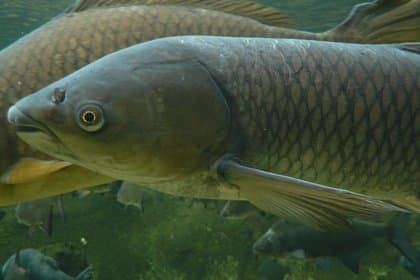Understanding Grass Carp: Biology, Habitat, and Fishing or Menace?
Grass carp (Ctenopharyngodon idella) is a species of freshwater fish that is known for its ability to consume large amounts of aquatic vegetation, making it a popular choice for controlling unwanted vegetation in ponds, lakes, and other freshwater bodies. However, as they can have a significant impact on the aquatic ecosystem, it is important to understand their biology, habitat, and potential effects on the environment. This article will provide a detailed overview of grass carp, including its biology, habitat, and potential effects on the environment. It will also discuss the management strategies and regulations that are needed to minimize the negative effects of grass carp on the environment.

Grass carp (Ctenopharyngodon idella) is a species of freshwater fish that is native to Asia and Eastern Europe. They are known for their ability to consume large amounts of aquatic vegetation, making them a popular choice for controlling unwanted vegetation in ponds, lakes, and other freshwater bodies. However, as they can have a significant impact on the aquatic ecosystem, it is important to understand their biology, habitat, and potential effects on the environment.
Biology
Grass carp are a large fish that can grow up to 4 feet in length and weigh up to 100 pounds. They have a typical carp-like body shape with a large dorsal fin and a forked tail. They are typically gray or green in color, with a white belly and large scales.
Grass carp are herbivores and feed primarily on aquatic plants. They have specialized teeth and jaw structure that allows them to shred and consume large quantities of vegetation. They are known to consume a wide variety of aquatic plants, including submerged, floating and emergent vegetation. They also have a high reproductive potential and can lay up to one million eggs per year, which increases their capacity to colonize new areas quickly.
Habitat
Grass carp are typically found in freshwater bodies such as lakes, ponds, rivers, and canals. They prefer slow-moving or still water with a moderate depth and a diverse range of aquatic vegetation. They can tolerate a wide range of water temperatures, but prefer water temperatures between 68 and 86 degrees Fahrenheit. They are also known to be able to tolerate a wide range of water chemistry conditions, such as pH levels and dissolved oxygen levels.
Blessing or Menace?
Grass carp have been widely used as a biological control measure for controlling unwanted aquatic vegetation in ponds, lakes, and other freshwater bodies. They are known to be effective at controlling invasive plant species and reducing the growth of nuisance plants. However, their ability to consume large amounts of vegetation can also have negative effects on the aquatic ecosystem.
Research has shown that grass carp can cause significant changes in the structure and function of aquatic ecosystems by reducing the diversity and abundance of aquatic plants. This can have a cascading effect on the entire ecosystem by reducing the habitat and food resources for other aquatic animals, such as insects, fish, and birds. Additionally, grass carp can also displace native fish species and disrupt the balance of the ecosystem.
It's worth noting that, Grass carp are not native to North America, and their introduction to new areas can also cause harm to native fish and plant species, as well as disrupt the balance of the ecosystem. Therefore, it is important to consider the potential effects of grass carp on the environment before introducing them to a new area.
In conclusion, grass carp are a species of freshwater fish that can be an effective control measure for unwanted aquatic vegetation. However, it is important to understand their biology, habitat, and potential effects on the environment before introducing them to a new area. In order to minimize the negative effects of grass carp on the environment, appropriate management strategies and regulations need to be implemented. Additionally, it is important to consider the use of alternative control measures, such as manual removal or chemical treatments, which can be more selective and less disruptive to the ecosystem.
No comments yet, be the first to share your thoughts!
Newsletter
Sign up for our newsletter and stay up-to-date on the latest tips, tricks, and techniques in carp fishing. From beginner to expert, our newsletter offers something for every level of angler. Do not miss out on exclusive content, product reviews and fishing reports that will help you catch more carp.
Related Posts
Zebrafish: A Model Organism for Biological Research
almost 3 years ago
Best Budget Bait Boats for Sale: Affordable Models for Every Angler
almost 3 years ago
20 Premier Carp Fishing Locations in the East Midlands (UK)
over 1 year ago
Mrigal Carp: Biology, Distribution, and Ecological Impact
almost 3 years ago
Understanding Grass Carp: Biology, Habitat, and Fishing or Menace?
almost 3 years ago
The 60 Best Fishing Gadgets for an Unforgettable Fishing Experience in 2023
almost 3 years ago